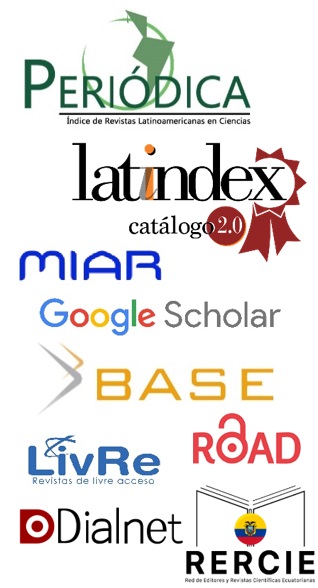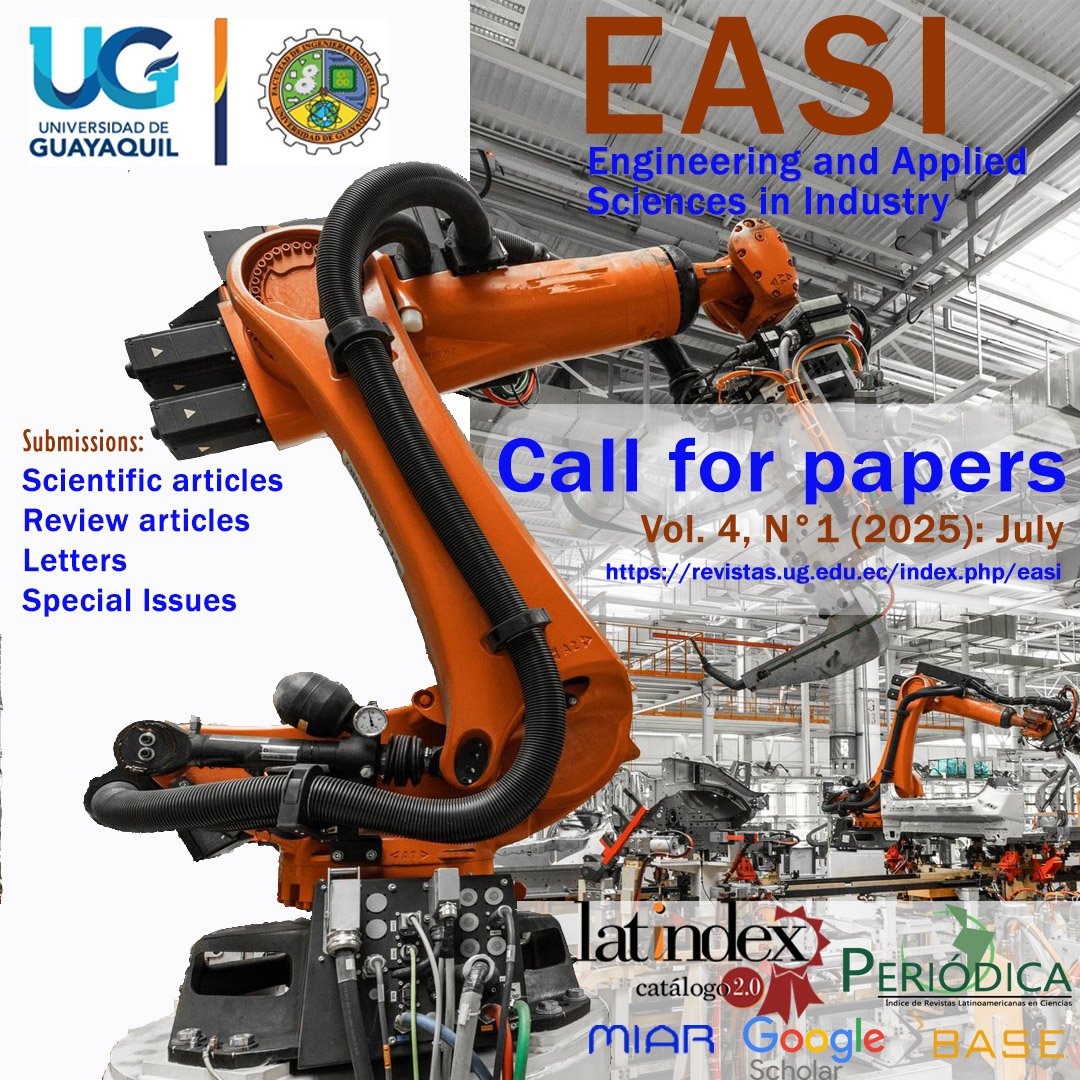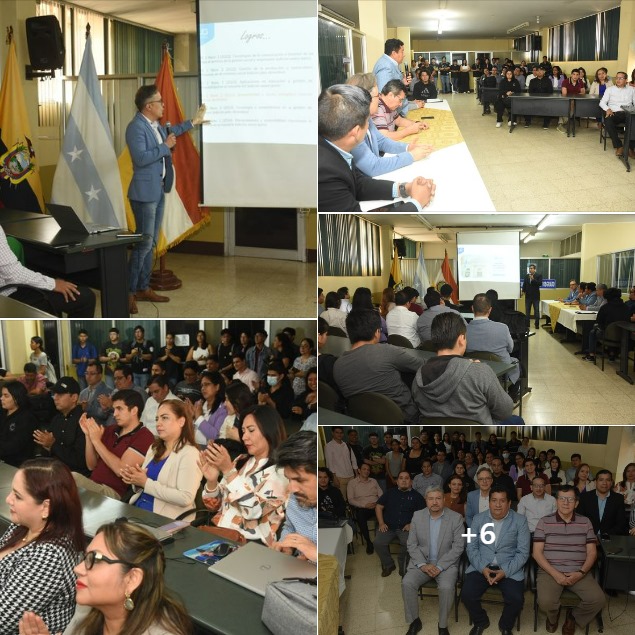Análisis no lineal multivariante de variables climatológicas y su efecto en la temperatura local
DOI:
https://doi.org/10.53591/easi.v3i1.0532Palabras clave:
Multiobjetivo, variables climatológicas, predicción estadísticaResumen
La temperatura atmosférica describe el grado de calor específico del aire en lugares y momentos específicos. En ese sentido, el trabajo presentado propone un sistema multivariable que toma conjuntos de datos de diferentes variables climatológicas, con el objetivo de regular el nivel de temperatura. La diversidad en las variables climatológicas afecta de forma importante las precipitaciones, la humedad, la velocidad del viento y la temperatura. Así, se ha realizado un estudio a partir de estas variables en términos de dinámica no lineal. El objetivo del trabajo se centra en obtener una mejor comprensión de la dinámica de las variables climatológicas locales. Por otra parte, debido a que las series temporales analizadas son pequeñas, el análisis se torna complejo, al momento de la unir todas las variables en conjunto, y de procesarlas por medio de metodologías de predicción estadística multivariable. Los resultados han mostrado los valores medios en las diferentes variables con los que se mantiene una temperatura entre y , lo que muestra posibles trabajos con la optimización multiobjetivo del modelo resultante.
Citas
Adwan, I., Milad, A., Memon, Z. A., Widyatmoko, I., Zanuri, N. A., Memon, N. A., & Yusoff, N. I. M. (2021). Asphalt pavement temperature prediction models: A review. In Applied Sciences (Switzerland) (Vol. 11, Issue 9). MDPI AG. https://doi.org/10.3390/app11093794
Arnell, N. W., Brown, S., Gosling, S. N., Gottschalk, P., Hinkel, J., Huntingford, C., Lloyd-Hughes, B., Lowe, J. A., Nicholls, R. J., Osborn, T. J., Osborne, T. M., Rose, G. A., Smith, P., Wheeler, T. R., & Zelazowski, P. (2016). The impacts of climate change across the globe: A multi-sectoral assessment. Climatic Change, 134(3), 457–474. https://doi.org/10.1007/s10584-014-1281-2
Arnell, N. W., Lowe, J. A., Challinor, A. J., & Osborn, T. J. (2019). Global and regional impacts of climate change at different levels of global temperature increase. Climatic Change, 155(3), 377–391. https://doi.org/10.1007/s10584-019-02464-z
Barange, Bahri, Beveridge, MCM, Cochrane, KL, Funge-Smith, Poulain, & eds. (2018). Impacts of climate change on fisheries and aquaculture. In United Nations’ Food and Agriculture Organization (Vol. 12, Issue 4, pp. 628–635).
Bracken, C., Holman, K. D., Rajagopalan, B., & Moradkhani, H. (2018). A Bayesian Hierarchical Approach to Multivariate Nonstationary Hydrologic Frequency Analysis. Water Resources Research, 54(1), 243–255. https://doi.org/10.1002/2017WR020403
Busuioc, A., Giorgi, F., Bi, X., & Ionita, M. (2006). Comparison of regional climate model and statistical downscaling simulations of different winter precipitation change scenarios over Romania. Theoretical and Applied Climatology, 86(1–4), 101–123. https://doi.org/10.1007/s00704-005-0210-8
Favre, A. C., Adlouni, S. El, Perreault, L., Thiémonge, N., & Bobée, B. (2004). Multivariate hydrological frequency analysis using copulas. Water Resources Research, 40(1). https://doi.org/10.1029/2003WR002456
Goyal, A. (2023). Exploring the Impact of Climate Change: A Comprehensive Dataset on Temperature. https://www.kaggle.com/datasets/goyaladi/climate-insights-dataset/data
Jin, Y.-H., Kawamura, A., Jinno, K., & Berndtsson, R. (2005). Nonlinear multivariable analysis of SOI and local precipitation and temperature. Nonlinear Processes in Geophysics, 12, 67–74. https://doi.org/https://doi.org/10.5194/npg-12-67-2005
Masson-Delmotte, V., Zhai, P., Pörtner, H. O., Roberts, D., Skea, J., Shukla, P. R., Pirani, A., Moufouma-Okia, W., Péan, C., Pidcock, R., & others. (2018). Global Warming of 1.5◦ C: Special Report. Intergovernmental Panel on Climate Change: Geneva, Switzerland. https://www.ipcc.ch/sr15/
Miao, Y., Zhang, C., Zhang, X., & Zhang, L. (2023). A Multivariable Convolutional Neural Network for Forecasting Synoptic-Scale Sea Surface Temperature Anomalies in the South China Sea. Weather and Forecasting, 38(6), 849–863. https://doi.org/10.1175/WAF-D-22-0094.1
Olson, B., & Kleiber, W. (2017). Approximate Bayesian computation methods for daily spatiotemporal precipitation occurrence simulation. Water Resources Research, 53(4), 3352–3372. https://doi.org/10.1002/2016WR019741
O’Neill, B. C., M Done, J., Gettelman, A., Lawrence, P., Lehner, F., Lamarque, J.-F., Lin, L., J Monaghan, A., Oleson, K., Ren, X., & others. (2018). The benefits of reduced anthropogenic climate change (BRACE): a synthesis. Climatic Change, 146, 287–301. https://doi.org/https://doi.org/10.1007/s10584-017-2009-x
Renard, B., Thyer, M., McInerney, D., Kavetski, D., Leonard, M., & Westra, S. (2022). A Hidden Climate Indices Modeling Framework for Multivariable Space-Time Data. Water Resources Research, 58(1). https://doi.org/10.1029/2021WR030007
Sesana, E., Gagnon, A. S., Ciantelli, C., Cassar, J. A., & Hughes, J. J. (2021). Climate change impacts on cultural heritage: A literature review. In Wiley Interdisciplinary Reviews: Climate Change (Vol. 12, Issue 4). John Wiley and Sons Inc. https://doi.org/10.1002/wcc.710
Solazzo, E., Bianconi, R., Hogrefe, C., Curci, G., Tuccella, P., Alyuz, U., Balzarini, A., Baro, R., Bellasio, R., Bieser, J., Brandt, J., Christensen, J. H., Colette, A., Francis, X., Fraser, A., Garcia Vivanco, M., Jiménez-Guerrero, P., Im, U., Manders, A., … Galmarini, S. (2017). Evaluation and error apportionment of an ensemble of atmospheric chemistry transport modeling systems: Multivariable temporal and spatial breakdown. Atmospheric Chemistry and Physics, 17(4), 3001–3054. https://doi.org/10.5194/acp-17-3001-2017
Tukimat, N. N. A., Harun, S., & Tadza, M. Y. M. (2019). The potential of canonical correlation analysis in multivariable screening of climate model. IOP Conference Series: Earth and Environmental Science, 365(1). https://doi.org/10.1088/1755-1315/365/1/012025
Zscheischler, J., Westra, S., Van Den Hurk, B. J. J. M., Seneviratne, S. I., Ward, P. J., Pitman, A., AghaKouchak, A., Bresch, D. N., Leonard, M., Wahl, T., & others. (2018). Future climate risk from compound events. Nature Climate Change, 8(6), 469–477. https://doi.org/https://doi.org/10.1038/s41558-018-0156-3
Descargas
Publicado
Cómo citar
Número
Sección
Licencia
Derechos de autor 2024 Gloria Vanegas Zabala, Franklin Samaniego, Cecilia Urquizo-Alvarez

Esta obra está bajo una licencia internacional Creative Commons Atribución-NoComercial-SinDerivadas 4.0.
Las contribuciones publicadas en la revista EASI se rigen por la licencia de acceso abierto CC BY-NC-ND 4.0 (Creative Commons Reconocimiento-NoComercial-SinDerivadas 4.0). Esta licencia te empodera como autor, y garantiza la amplia difusión de tu investigación mientras protege tus derechos.
Para autores:
- Los autores pueden reproducir y distribuir la obra en cualquier formato no comercial, siempre que la obra indique los autores y datos de la revista EASI, y no contravenga los puntos mencionados en el apartado de los permisos y prácticas editoriales.
- La revista obtiene una licencia para publicar y distribuir el manuscrito original.
Para lectores/usuarios:
Acceso y distribución gratuita: cualquier lector o usuario puede acceder, descargar, copiar, imprimir y compartir el artículo publicado libremente según los términos de la licencia CC BY-NC-ND 4.0.
Reconocimiento obligatorio: si un tercero utiliza el material publicado, debe dar crédito al creador proporcionando el nombre, el título del artículo y el nombre de la revista, lo que garantiza la propiedad intelectual del autor(es) y ayuda a construir su reputación académica.
Uso no comercial: solo se permite el uso no comercial del trabajo publicado. No comercial significa que no está destinado principalmente ni dirigido al aprovechamiento comercial o la compensación monetaria por parte de ningún tercero.
No se permiten modificaciones: el contenido del artículo publicado no se puede cambiar, mezclar o reconstruir a partir del trabajo del autor. Esto asegura la integridad y precisión de los resultados de la investigación.




